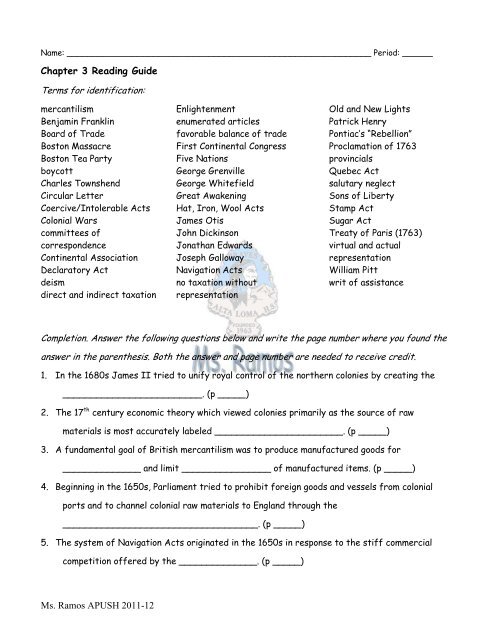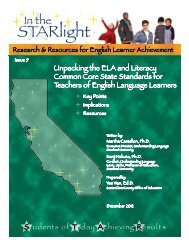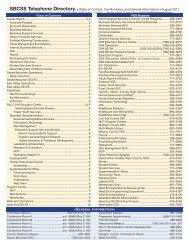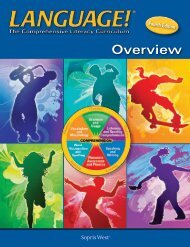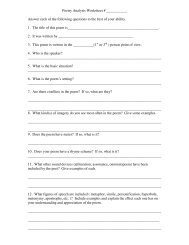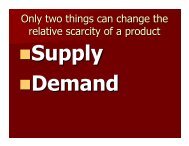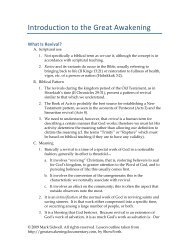Chapter 3 Reading Guide
Chapter 3 Reading Guide
Chapter 3 Reading Guide
- No tags were found...
Create successful ePaper yourself
Turn your PDF publications into a flip-book with our unique Google optimized e-Paper software.
Name: ____________________________________________________________ Period: ______<strong>Chapter</strong> 3 <strong>Reading</strong> <strong>Guide</strong>Terms for identification:mercantilismBenjamin FranklinBoard of TradeBoston MassacreBoston Tea PartyboycottCharles TownshendCircular LetterCoercive/Intolerable ActsColonial Warscommittees ofcorrespondenceContinental AssociationDeclaratory Actdeismdirect and indirect taxationEnlightenmentenumerated articlesfavorable balance of tradeFirst Continental CongressFive NationsGeorge GrenvilleGeorge WhitefieldGreat AwakeningHat, Iron, Wool ActsJames OtisJohn DickinsonJonathan EdwardsJoseph GallowayNavigation Actsno taxation withoutrepresentationOld and New LightsPatrick HenryPontiac’s “Rebellion”Proclamation of 1763provincialsQuebec Actsalutary neglectSons of LibertyStamp ActSugar ActTreaty of Paris (1763)virtual and actualrepresentationWilliam Pittwrit of assistanceCompletion. Answer the following questions below and write the page number where you found theanswer in the parenthesis. Both the answer and page number are needed to receive credit.1. In the 1680s James II tried to unify royal control of the northern colonies by creating the_________________________. (p _____)2. The 17 th century economic theory which viewed colonies primarily as the source of rawmaterials is most accurately labeled _______________________. (p _____)3. A fundamental goal of British mercantilism was to produce manufactured goods for______________ and limit ________________ of manufactured items. (p _____)4. Beginning in the 1650s, Parliament tried to prohibit foreign goods and vessels from colonialports and to channel colonial raw materials to England through the___________________________________. (p _____)5. The system of Navigation Acts originated in the 1650s in response to the stiff commercialcompetition offered by the ______________. (p _____)Ms. Ramos APUSH 2011-12
6. The “enumeration” principle in the Navigation Act of 1660 required that certain commoditieslike ____________, _________________, and indigo could not be outside the____________________________________. (p _____)7. George Whitefield’s greatest contribution to the Great Awakening was his ability to stir anaudience emotionally with his __________________. (p _____)8. The most famous native born revivalist of the Great Awakening was the intellectually brilliantauthor of sermons such as “Sinners in the Hands of an Angry God.” He was__________________________________. (p _____)9. The view that the universe is based on impersonal, scientific laws which govern the behavior ofall matter, animate and inanimate, was basic to the _______________________. (p _____)10. The greatest source of trouble between the French in Canada and the British in New Englandwas the control over the ________________________________. (p _____)11. In 1758 ________________________________ took over British leadership of the Frenchand Indian War, pouring soldiers and money into North America. (p _____)12. Under the Treaty of Paris (1763) ending the ___________________________War, Francelost all her possessions on the mainland of North America. (p _____)13. The British victory in the French and Indian War was due largely to ______________ soldiersfinanced by the British government. (p _____)14. In governing their American Empire after 1763, the new problem which faced the British wasgreatly increased _______________ of administering a far larger and more complex empire.(p _____)15. In 1763 the Ottawa chief who led one last effort to drive the whites out of the Ohio Valley andacross the Appalachians was _______________________. (p_____)16. The purpose of the Proclamation of 1763 was to check colonial expansion across the___________________________. (p _____)17. In an effort to help support the increased cost of colonial administration, Parliament passedthe _____________ Act in 1764, placing tariffs on coffee and wines, and doubling taxes onEuropean items imported through Great Britain. (p _____)Ms. Ramos APUSH 2011-12
18. The concept that every member of Parliament stood for the interests of the entire empire wascalled _______________________ representation. (p _____)19. American protests against the Stamp Act were vehement because it taxed__________________ most heavily. (p _____)20. The Stamp Act was repealed in 1776 primarily because of the pressure from British merchantswho had been hurt by the American __________________. (p _____)21. On the same day it repealed the Stamp Act, Parliament passed the _________________ Actstating that the colonies were “subordinate” to its wishes. (p _____)22. Parliament’s main goal in the Tea Act of 1773 was to aid the__________________________.(p _____)23. The most important American objection to the Tea Act of 1773 was that it seemed to be atrick to trap Americans into paying the _______________________ duty on tea. (p _____)24. The militant Boston leader of resistance to the Tea Act and of the “Boston Tea Party” was_____________________________________. (p _____)25. Which of the following “Intolerable Acts” was actually unrelated to British retaliation for theBoston Tea Party: Boston Port Act, Massachusetts Governing Act, Administration of JusticeAct, or the Quebec Act? ___________________________________________ (p _____)26. The most conservative proposal before the First Continental Congress in 1774 was the______________________________________________. (p _____)Ms. Ramos APUSH 2011-12


